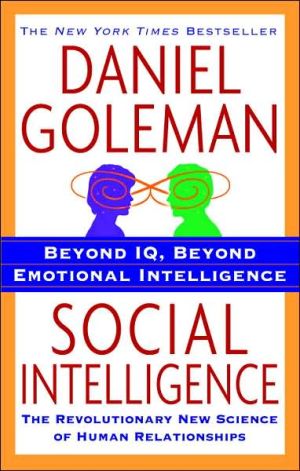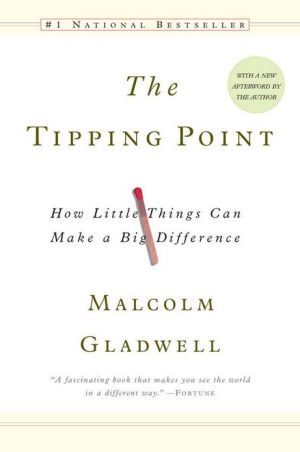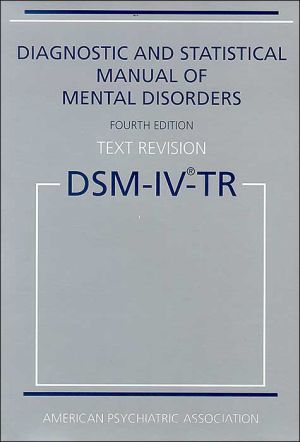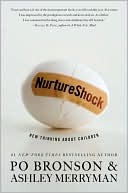Social Intelligence: The New Science of Human Relationships
Emotional Intelligence was an international phenomenon, appearing on the New York Times bestseller list for over a year and selling more than five million copies worldwide. Now, once again, Daniel Goleman has written a groundbreaking synthesis of the latest findings in biology and brain science, revealing that we are “wired to connect” and the surprisingly deep impact of our relationships on every aspect of our lives.\ Far more than we are consciously aware, our daily encounters with parents,...
Search in google:
Just as Emotional Intelligence redefined what it means to be smart, Daniel Goleman’s major new audiobook transforms our understanding of relationships, from our most intimate moments to the crucial social issues of our time Publishers Weekly In this companion volume to his bestseller, Emotional Intelligence, Goleman persuasively argues for a new social model of intelligence drawn from the emerging field of social neuroscience. Describing what happens to our brains when we connect with others, Goleman demonstrates how relationships have the power to mold not only human experience but also human biology. In lucid prose he describes from a neurobiological perspective sexual attraction, marriage, parenting, psychopathic behaviors and the group dynamics of teachers and workers. Goleman frames his discussion in a critique of society's creeping disconnection in the age of the iPod, constant digital connectivity and multitasking. Vividly evoking the power of social interaction to influence mood and brain chemistry, Goleman discusses the "toxicity" of insult and unpleasant social experience as he warns of the dangers of self-absorption and poor attention and reveals the positive effects of feel-good neurochemicals that are released in loving relationships and in caregiving. Drawing on numerous studies, Goleman illuminates new theories about attachment, bonding, and the making and remaking of memory as he examines how our brains are wired for altruism, compassion, concern and rapport. The massive audience for Emotional Intelligence will revel in Goleman's latest passionately argued case for the benefits to society of empathetic social attunement. (Oct. 3) Copyright 2006 Reed Business Information.
Chapter One\ \ The Emotional Economy\ One day, late for a meeting in midtown Manhattan, I was looking for a shortcut. So I walked into an indoor atrium on the ground floor of a skyscraper, planning to use an exit door I had spotted on the other side that would give me a faster route through the block.\ But as soon as I reached the building's lobby, with its banks of elevators, a uniformed guard stormed over to me, waving his arms and yelling, "You can't walk through here!"\ "Why not?" I asked, puzzled.\ "Private property! It's private property!" he shouted, visibly agitated.\ I seemed to have inadvertently intruded into an unmarked security zone. "It would help," I suggested in a shaky attempt to infuse a bit of reasoning, "if there were a sign on the door saying 'Do Not Enter.' "\ My remark made him even angrier. "Get out! Get out!" he screamed.\ Unsettled, I hastily beat my retreat, his anger reverberating in my own gut for the next several blocks.\ When someone dumps their toxic feelings on us–explodes in anger or threats, shows disgust or contempt–they activate in us circuitry for those very same distressing emotions. Their act has potent neurological consequences: emotions are contagious. We "catch" strong emotions much as we do a rhinovirus–and so can come down with the emotional equivalent of a cold.\ Every interaction has an emotional subtext. Along with whatever else we are doing, we can make each other feel a little better, or even a lot better, or a little worse–or a lot worse, as happened to me. Beyond what transpires in the moment, we can retain a mood that stays with us long after the direct encounter ends–an emotional afterglow (or afterglower, in my case).\ These tacit transactions drive what amounts to an emotional economy, the net inner gains and losses we experience with a given person, or in a given conversation, or on any given day. By evening the net balance of feelings we have exchanged largely determines what kind of day–"good" or "bad"–we feel we've had.\ We participate in this interpersonal economy whenever a social interaction results in a transfer of feeling–which is virtually always. Such interpersonal judo has countless variations, but they all come down to our ability to change another person's mood, and they ours. When I make you frown, I evoke in you a touch of worry; when you make me smile, I feel happy. In this clandestine exchange, emotions pass from person to person, from outside to inside–hopefully for the best.\ A downside of emotional contagion comes when we take on a toxic state simply by being around the wrong person at the wrong time. I was an unwitting victim of that security guard's fury. Like secondhand smoke, the leakage of emotions can make a bystander an innocent casualty of someone else's toxic state.\ In moments like mine with that guard, as we confront someone's anger, our brain automatically scans to see if it signals some further danger. The resulting hypervigilance is driven largely by the amygdala, an almond-shaped area in the midbrain that triggers the fight, flight, or freeze response to danger. Of the entire range of feeling, fear most powerfully arouses the amygdala.\ When it is driven by alarm, the amygdala's extensive circuitry commandeers key points throughout the brain, shepherding our thoughts, attention, and perception toward whatever has made us afraid. We instinctively become more attentive to the faces of the people around us, searching for smiles or frowns that give us a better sense of how to interpret signs of danger or that might signal someone's intentions.\ This increased amygdala-driven vigilance heightens our alertness to emotional cues in other people. That intensified focus in turn more powerfully evokes their feelings in us, lubricating contagion. And so our moments of apprehension increase our susceptibility to another person's emotions.\ More generally, the amygdala acts as a radar for the brain, calling attention to whatever might be new, puzzling, or important to learn more about. The amygdala operates the brain's early warning system, scanning everything that happens, ever vigilant for emotionally salient events–especially for potential threats. While the amygdala's role as a sentinel and trigger for distress is old news to neuroscience, its social role, as part of the brain's system for emotional contagion, has been revealed only recently.\ THE LOW ROAD: CONTAGION CENTRAL\ A man doctors call Patient X had suffered two strokes that destroyed the connections between his eyes and the rest of the brain's system for sight in the visual cortex. Though his eyes could take in signals, his brain could not decipher them, nor even register their arrival. Patient X was completely blind–or so it seemed.\ On tests where Patient X was presented with various shapes like circles and squares, or photos of faces of men and women, he hadn't a clue what his eyes were gazing at. Yet when he was shown pictures of people with angry or happy faces, he suddenly was able to guess the emotions expressed, at a rate far better than chance. But how?\ Brain scans taken while Patient X guessed the feelings revealed an alternative to the usual pathways for seeing that flow from the eyes to the thalamus, where all the senses first enter the brain, and then to the visual cortex. The second route sends information straight from the thalamus to the amygdala (the brain has a pair, right and left). The amygdala then extracts emotional meaning from the nonverbal message, whether it be a scowl, a sudden change of posture, or a shift in tone of voice–even microseconds before we yet know what we are looking at.\ Though the amygdala has an exquisite sensitivity for such messages, its wiring provides no direct access to the centers for speech; in this sense the amygdala is, literally, speechless. When we register a feeling, signals from our brain circuits, instead of alerting the verbal areas, where words can express what we know, mimic that emotion in our own bodies. So Patient X was not seeing the emotions on the faces so much as feeling them, a condition called "affective blindsight."\ In intact brains, the amygdala uses this same pathway to read the emotional aspect of whatever we perceive–elation in someone's tone of voice, a hint of anger around the eyes, a posture of glum defeat–and then processes that information subliminally, beneath the reach of conscious awareness. This reflexive, unconscious awareness signals that emotion by priming the same feeling (or a reaction to it, such as fear on seeing anger) in us–a key mechanism for "catching" a feeling from someone else.\ The fact that we can trigger any emotion at all in someone else–or they in us–testifies to the powerful mechanism by which one person's feelings spread to another. Such contagions are the central transaction in the emotional economy, the give-and-take of feeling that accompanies every human encounter we have, no matter what the ostensible business at hand may be.\ Take, for example, the cashier at a local supermarket whose upbeat patter infects each of his customers in turn. He's always getting people to laugh–even the most doleful folks leave smiling. People like that cashier act as the emotional equivalent of zeitgebers, those forces in nature that entrain our biological rhythms to their own pace.\ Such a contagion can occur with many people at one time, as visibly as when an audience mists up at a tragic movie scene, or as subtly as the tone of a meeting turning a bit testy. Though we may perceive the visible consequences of this contagion, we are largely oblivious to exactly how emotions spread.\ Emotional contagion exemplifies what can be called the brain's "low road" at work. The low road is circuitry that operates beneath our awareness, automatically and effortlessly, with immense speed. Most of what we do seems to be piloted by massive neural networks operating via the low road–particularly in our emotional life. When we are captivated by an attractive face, or sense the sarcasm in a remark, we have the low road to thank.\ The "high road," in contrast, runs through neural systems that work more methodically and step by step, with deliberate effort. We are aware of the high road, and it gives us at least some control over our inner life, which the low road denies us. As we ponder ways to approach that attractive person, or search for an artful riposte to sarcasm, we take the high road.\ The low road can be seen as "wet," dripping with emotion, and the high road as relatively "dry," coolly rational. The low road traffics in raw feelings, the high in a considered understanding of what's going on. The low road lets us immediately feel with someone else; the high road can think about what we feel. Ordinarily they mesh seamlessly. Our social lives are governed by the interplay of these two modes [see Appendix A for details].\ An emotion can pass from person to person silently, without anyone consciously noticing, because the circuitry for this contagion lies in the low road. To oversimplify, the low road uses neural circuitry that runs through the amygdala and similar automatic nodes, while the high road sends inputs to the prefrontal cortex, the brain's executive center, which contains our capacity for intentionality–we can think about what's happening to us.\ The two roads register information at very different speeds. The low road is faster than it is accurate; the high road, while slower, can help us arrive at a more accurate view of what's going on. The low road is quick and dirty, the high slow but mindful. In the words of the twentieth-century philosopher John Dewey, one operates "slam-bang, act-first and think-afterwards," while the other is more "wary and observant."\ The speed differential between these two systems–the instant emotional one is several times faster in brain time than the more rational one–allows us to make snap decisions that we might later regret or need to justify. By the time the low road has reacted, sometimes all the high road can do is make the best of things. As the science fiction writer Robert Heinlein wryly noted, "Man is not a rational animal, but a rationalizing one."\ MOOD DRIVERS\ While visiting a certain region of the country, I remember being pleasantly surprised by the friendly tones of the taped voice on the telephone that informed me, "Your call cannot be completed as dialed."\ The warmth in that bland recorded message, believe it or not, gave me a small trill of good feeling–due largely to my years of irritation with that same message as delivered by my own regional phone company's computerized voice back home. For some reason, the technicians who programmed that message had decided that a grating, hectoring tone hit the right note, perhaps as an immediate punishment for misdialing.\ I had grown to resent the obnoxious tones of that taped message–it brought to my mind the image of a too-prissy, judgmental busybody. Without fail, it put me in a bad mood, if just for a moment.\ The emotional power of such subtle cues can be surprising. Consider a clever experiment done with student volunteers at the University of Würzburg in Germany. Students listened to a taped voice reading the driest of intellectual material, a German translation of the British philosopher David Hume's Philosophical Essay Concerning Human Understanding. The tape came in two versions, either happy or sad, but so subtly inflected that people were unaware of the difference unless they explicitly listened for it.\ As muted as the feeling tones were, students came away from the tape either slightly happier or slightly more somber than they had been before listening to it. Yet the students had no idea that their mood had shifted, let alone why.\ The mood shift occurred even when the students performed a distracting task–putting metal pins into holes in a wooden board–as they listened. The distraction, it seems, created static for the high road, hampering intellectual understanding of the philosophical passage. But it did not lessen a whit how contagious the moods were: the low road stayed wide open.\ One way moods differ from the grosser feeling of emotions, psychologists tell us, has to do with the ineffability of their causes: while we typically know what has triggered an outright emotion, we often find ourselves in one or another mood without knowing its source. The Würzburg experiment suggests, though, that our world may be filled with mood triggers that we fail to notice–everything from the saccharine Muzak in an elevator to the sour tone in someone's voice.\ For instance, take the expressions we see on other people's faces. As Swedish researchers found, merely seeing a picture of a happy face elicits fleeting activity in the muscles that pull the mouth into a smile. Indeed, whenever we gaze at a photograph of someone whose face displays a strong emotion, like sadness, disgust, or joy, our facial muscles automatically start to mirror the other's facial expression.\ This reflexive imitation opens us to subtle emotional influences from those around us, adding one lane in what amounts to a brain-to-brain bridge between people. Particularly sensitive people pick up this contagion more readily than most, though the impervious may sail through even the most toxic encounter. In either case, this transaction usually goes on undetected.\ We mimic the happiness of a smiling face, pulling our own facial muscles into a subtle grin, even though we may be unaware that we have seen the smile. That mimicked slight smile might not be obvious to the naked eye, but scientists monitoring facial muscles track such emotional mirroring clearly. It's as though our face were being preset, getting ready to display the full emotion.\ This mimicry has a bit of biological consequence, since our facial expressions trigger within us the feelings we display. We can stir any emotion by intentionally setting our facial muscles for that feeling: just clench a pencil in your teeth, and you will force your face into a smile, which subtly evokes a positive feeling.\ Edgar Allan Poe had an intuitive grasp of this principle. He wrote: "When I wish to find out how good or how wicked anyone is, or what are his thoughts at the moment, I fashion the expression of my face, as accurately as possible, in accordance with the expression of his, and then wait to see what thoughts or sentiments arise in my own mind or heart, as if to match or correspond with the expression."\ CATCHING EMOTIONS\ The scene: Paris, 1895. A handful of adventurous souls have ventured into an exhibition by the Lumière brothers, pioneers in photography. For the first time in history, the brothers are presenting to the public a "moving picture," a short film depicting–in utter silence–a train chugging into a station, spewing steam and charging toward the camera.\ The audience's reaction: they scream in terror and duck under their seats.\ People had never before seen pictures move. This utterly naïve audience could not help but register as "real" the eerie specter on the screen. The most magical, powerful event in film history may well have been these very first moments in Paris, because the realization that what the eye saw was merely an illusion had not registered with any of the viewers. So far as they–and their brain's perceptual system–were concerned, the images on the screen were reality.\ As one movie critic points out, "The dominating impression that this is real is a large part of the primitive power of the art form," even today. That sense of reality continues to ensnare filmgoers because the brain responds to the illusion created by the film with the same circuitry as it does to life itself. Even onscreen emotions are contagious.
Prologue: Unveiling a New Science 3Wired to ConnectThe Emotional Economy 13A Recipe for Rapport 27Neural WiFi 38An Instinct for Altruism 50The Neuroanatomy of a Kiss 63What Is Social Intelligence? 82Broken BondsYou and It 105The Dark Triad 117Mindblind 133Nurturing NatureGenes Are Not Destiny 147A Secure Base 162The Set Point for Happiness 173Love's VarietiesWebs of Attachment 189Desire: His and Hers 198The Biology of Compassion 211Healthy ConnectionsStress Is Social 223Biological Allies 238A People Prescription 250Social ConsequenceThe Sweet Spot for Achievement 267The Connectedness Corrective 285From Them to Us 298Epilogue: What Really Matters 311The High and Low Roads: A Note 321The Social Brain 323Rethinking Social Intelligence 329Acknowledgments 335Notes 337Index 393About the Author 405
\ Publishers WeeklyIn this companion volume to his bestseller, Emotional Intelligence, Goleman persuasively argues for a new social model of intelligence drawn from the emerging field of social neuroscience. Describing what happens to our brains when we connect with others, Goleman demonstrates how relationships have the power to mold not only human experience but also human biology. In lucid prose he describes from a neurobiological perspective sexual attraction, marriage, parenting, psychopathic behaviors and the group dynamics of teachers and workers. Goleman frames his discussion in a critique of society's creeping disconnection in the age of the iPod, constant digital connectivity and multitasking. Vividly evoking the power of social interaction to influence mood and brain chemistry, Goleman discusses the "toxicity" of insult and unpleasant social experience as he warns of the dangers of self-absorption and poor attention and reveals the positive effects of feel-good neurochemicals that are released in loving relationships and in caregiving. Drawing on numerous studies, Goleman illuminates new theories about attachment, bonding, and the making and remaking of memory as he examines how our brains are wired for altruism, compassion, concern and rapport. The massive audience for Emotional Intelligence will revel in Goleman's latest passionately argued case for the benefits to society of empathetic social attunement. (Oct. 3) Copyright 2006 Reed Business Information.\ \ \ \ \ Library JournalIntelligence guru Goleman (Emotional Intelligence: Why It Can Matter More Than IQ) once again puts his Harvard psychology doctorate to work as he continues to examine facets of human intelligence. Like Robert J. Sternberg and Richard K. Wagner in their coauthored books Practical Intelligence: Nature and Origins of Competence in the Everyday World and Mind in Context: Interactionist Perspectives on Human Intelligence, Goleman posits dimensions to intelligence involving emotional and interactional components and complementing reasoning ability to yield a more holistic measure of intelligence. He explores the psychobiology and social neuroscience of human relationships, citing research supporting the notion that humans are hardwired to interact with others. Social intelligence involves self-awareness as well as attunement toward others and toward relationships as a whole. Goleman argues that neurotransmitters create "Neural WiFi," enabling us to connect positively to others and to our world. As a superb and essential corollary to Goleman's important work on emotional intelligence, Social Intelligence is indispensable for all university and public library psychology collections. [See Prepub Alert, LJ 5/1/06.]-Lynne F. Maxwell, Villanova Univ. Sch. of Law Lib., PA Copyright 2006 Reed Business Information.\ \








